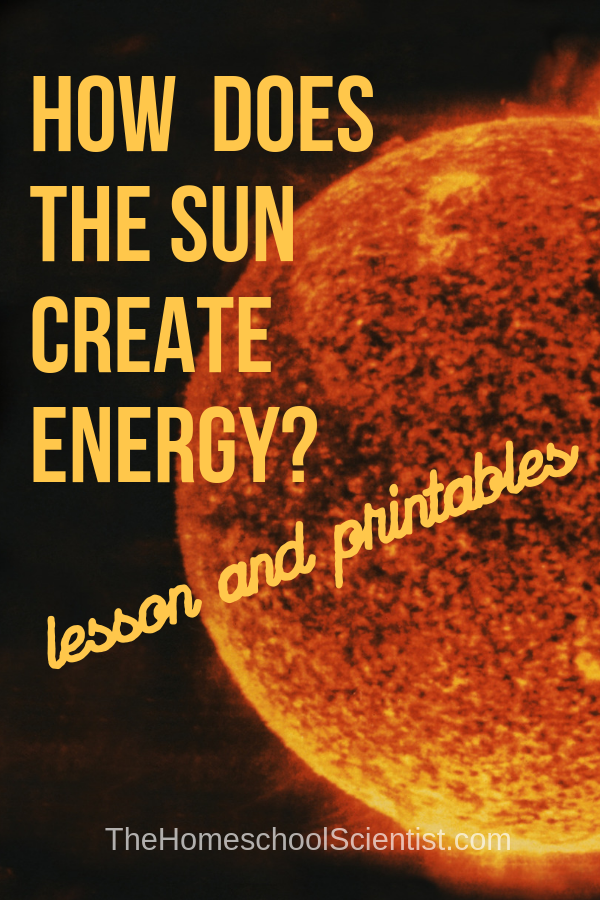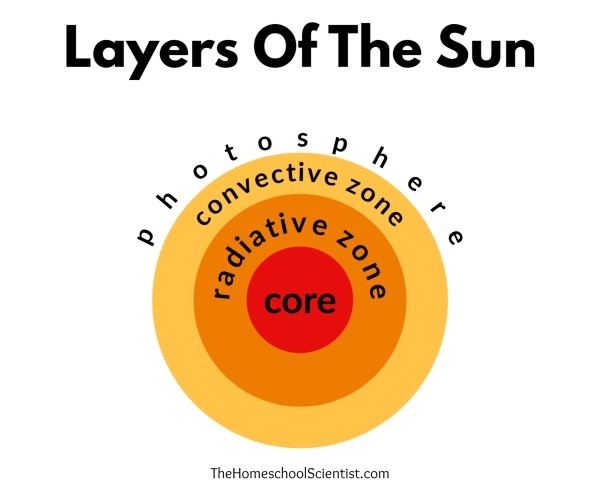
This hands-on lesson helps students understand how the sun creates energy. 30 pages of information, hands-on activities, printables, & mini-posters that helps students understand how the Sun produces energy.
Step outside into the sunshine. Feel the warmth that comes from its rays. That’s energy. Notice how the sunlight illuminates everything in the daytime. That’s energy. How does the sun create energy?
Energy can be defined as the capacity to do work. This may be in the form of kinetic, nuclear, potential, chemical, or other forms of energy. The energy that comes from the sun is in the form of heat and light. This energy is essential for life on Earth and we are discovering ways to harness that energy to make life on the planet better.
But, how does the sun create energy? How does that energy get all the way to Earth? Is the sun’s energy really that important? Let’s learn all about how the Sun produces energy.
Why Is The Sun’s Energy Important?
The Sun is a massive power plant that fuels the Earth. You could say that the Earth is solar powered. Without the energy from the Sun, life on our planet wouldn’t exist. Plants require sunlight to create their own food through photosynthesis. Animals need plants as a food source either directly or to feed the other animals that they eat. Animals, also, need plants to make the oxygen they need to breathe.

Energy from the sun, also, drives the Earth’s natural cycles. The heat from the sun creates convection currents that cause winds to blow and generate ocean currents. Heat energy from the sun is key in the Earth’s water cycle. Without the water cycle, we would not have any fresh water to drink. Also, without the heat from the sun, planet Earth would be in a deep freeze!
Related post: Convection Current Experiment
Sun Factoids and How the Sun Creates Energy
Our sun sits in the center of our solar system and considered to be a yellow dwarf star. The sun is given this classification by scientists because of its mass and the fact that it radiates yellow to white light. It is this light that contains the sun’s energy.
It is the sun’s gravitational force that holds the planets in their orbits and keeps them from spinning off into the universe. The gravitation force of the sun is generated by its size and mass. The sun is the largest object in our solar system containing 99.8% of its total mass. At 864,000 miles (1.4 million Km) wide, the sun is 109 times wider than Earth.
Related post: Solar System Printables
Even though the Sun contains mass, it is not solid like the Earth. Made up mainly of hydrogen (91%) and helium, the sun is actually a swirling mass of gas and plasma. Plasma is the 4th state of matter. The other three being solid, liquid, and gas.
Plasma forms when gas gets so hot that atoms break apart and basically form a cloud of protons, neutrons and electrons that have the ability to act as a whole rather than as a bunch of different atoms. Often, this plasma seems to flow like a liquid.
Even though the sun is not a solid, it can still be divided into zones: the core, the radiative zone, and the convective zone. To understand how the sun creates energy, we need to learn about these layers.

Layers Of The Sun
Core
The core of the sun is located in its very center. This zone is where the sun’s energy is produced. The temperature of the sun’s core is approximately 27 million degrees F (15 million C). Pressure inside the sun’s core is also very high. The large mass of the sun pressing in on the core gives it an incredible pressure of 250 billion atmospheres.
This extreme heat and pressure is enough to sustain thermonuclear fusion in the Earth’s core. Fusion takes place when atoms combine to form larger atoms. In the core of the sun, hydrogen atoms fuse to create helium atoms. This process releases massive amounts of energy.
Radiative Zone
The energy created by nuclear fusion in the Sun’s core is carried by photons, light particles, into the radiative zone of the sun. As the energy carried by the photons radiates through the radiative zone, they do not take a straight path. The photons bounce around the layer from particle to particle being held by each one for a small amount of time. Since the density of the plasma in this layer is so high, it can take thousands of years for a single photon to make its way through and into the convective zone.

Convective Zone
The convective zone of the Sun extends from the radiative zone to the Sun’s surface. This zone makes up approximately 66% of the Sun’s volume but only about 2% of its mass because it contains mostly gas. The temperature of the convection zone is much cooler than the Sun’s core at about 10,000 F (5,500 C). Energy is transported relatively quickly through the convective zone and out to the Sun’s surface, the photosphere.
Photosphere
The sun’s surface is called the photosphere. When photons that have traveled from the sun’s core reaches the photosphere, they move rapidly through the sun’s atmosphere and into space radiating in all directions. Here on Earth we can see the energy that leaves the surface of the Sun as sunlight eight minutes after it leaves the Sun.
Sunlight is made of solar photons. These photons travel 186,000 miles/second for 93 million miles. This distance is also called an astronomical unit (AU). In our download below, there is an activity teaching students about astronomical units.
Uses For The Sun’s Energy

- Generate electricity using solar cells
- Recharging electronics with solar powered chargers
- Heating water for use in houses and businesses
- Solar powered lights
What other ways can we use the Sun’s energy?
Find out all about solar energy and how the Sun makes energy in our FREE 30+ page printable unit – Energizing Science: The Sun and How it Creates Energy.
How Does The Sun Create Energy? Download the FREE Lesson Printable!
Get this lesson as a printable, plus get an included short quiz. Subscribe to The Homeschool Scientist email list in the form below and I will send it to your inbox asap. If you already subscribe, fill out the form just to let me know you want this printable and I will send it to you. You will not be subscribing twice.
Sun Science Activities
The heat from the Sun creates convection currents that cause winds to blow and generate ocean currents. Heat energy from the sun is key in the Earth’s water cycle.
How The Sun Affects The Temperature
Fractals Suncatchers STEAM Activity
Solar Printing Science Activity
